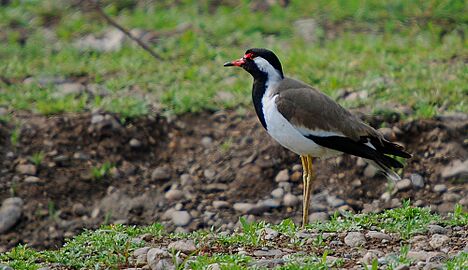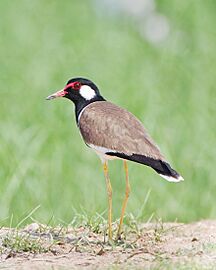Red-wattled lapwing facts for kids
Quick facts for kids Red-wattled lapwing |
|
|---|---|
 |
|
| Vanellus indicus indicus |
|
| Conservation status | |
| Scientific classification | |
| Genus: |
Vanellus
|
| Species: |
indicus
|
 |
|
| Bounding distribution range | |
| Synonyms | |
|
Hoplopterus indicus |
|
The red-wattled lapwing (Vanellus indicus) is a type of bird found in Asia. It's a large plover, which is a kind of wader bird. These birds live on the ground and cannot perch on branches like many other birds.
Red-wattled lapwings are known for their very loud alarm calls. People often describe these sounds as "did he do it" or "pity to do it." Because of this, they are sometimes called the "did-he-do-it" bird! Their calls warn other animals and people when something is moving nearby.
You usually see these birds in pairs or small groups near water. Sometimes, when it's not breeding season (in winter), many of them gather together in large groups. They build their nests on the ground and lay three to four eggs that are hard to see because they are camouflaged. When predators come near, the adult birds fly around, diving and making a lot of noise to scare them away. The baby chicks are also camouflaged and follow their parents right after hatching. They hide by lying very still on the ground or in the grass if they feel threatened.
Contents
About the Red-wattled Lapwing
People have known about the Red-wattled Lapwing for a long time. The bird was first described in a book in 1781 by a French scientist named Georges-Louis Leclerc, Comte de Buffon. Later, in 1783, a Dutch scientist named Pieter Boddaert gave it the scientific name Tringa indica.
The Red-wattled Lapwing's scientific name today is Vanellus indicus. The word Vanellus comes from a Latin word meaning "lapwing." It also relates to a word meaning "winnowing" or "fan," which might describe how they fly. The word indicus means "from India."
Different Types of Lapwings
Across the wide area where they live, Red-wattled Lapwings have small differences in their feathers. Because of these differences, scientists recognize four main types, called subspecies:
- V. i. aigneri: Found from southeast Turkey to Pakistan.
- V. i. indicus: Found from central Pakistan to Nepal, northeast India, and Bangladesh.
- V. i. lankae: Found in Sri Lanka.
- V. i. atronuchalis: Found from northeast India to south China, Southeast Asia, the Malay Peninsula, and north Sumatra.
-
V. i. aigneri
from Turkey. -
V. i. atronuchalis showing the white ear patch surrounded by black, from Thailand.
-
V. i. lankae
from Sri Lanka.
What They Look Like
Red-wattled Lapwings are large waders, which means they are birds that wade in water. They are about 35 centimeters (14 inches) long. Their wings and back are light brown with a shiny purple or green color. Their head, and a patch on the front and back of their neck, are black.
They have a bright white stripe that runs between these colors, from their belly and tail, up the sides of their neck to their head. Their short tail has a black tip. A special feature is the red, fleshy skin called a wattle in front of each eye. Their bill is red with a black tip, and their long legs are yellow. When they fly, you can see clear white bars on their wings.
The different subspecies have slight differences in size and color. For example, the aigneri type is a bit paler and larger than the main type found in India. The Sri Lankan type (lankae) is smaller and darker.
Males and females look very similar. Males usually have slightly longer wings. These birds are about 32 to 35 centimeters long.
Where They Live
Red-wattled Lapwings usually live in pairs or small groups in open areas with water. This includes plowed fields, grazing lands, and the edges of ponds or puddles. Sometimes, they form large groups of 26 to 200 birds. You can also find them in forest clearings near areas filled with rain.
They run in short bursts and then lean forward to pick up food, just like other plover birds. They are very watchful, day and night, and are often the first to notice if something new enters their area, making a loud alarm call. Their flight is a bit slow, but they can move very quickly when protecting their nest or escaping from a hawk.
Sometimes, lapwings are born with unusual white patches in their feathers, a condition called leucism.
Local Names
Many local names for the Red-wattled Lapwing sound like its call. For example:
- Hindi: titahri
- Marathi: titawi
- Kannada: tittibha
- Sindhi: tateehar
- Gujarati: titodi
- Kashmiri: hatatut
- Assamese: balighora
- Telugu: yennappa chitawa
- Tamil: aal-kaati (meaning "human indicator")
Where to Find Them
Red-wattled Lapwings breed from West Asia (like Iraq and Iran) all the way across South Asia (including Sri Lanka, Afghanistan, Pakistan, and all of India). They can be found up to 1800 meters (about 5,900 feet) high in places like Kashmir and Nepal. Another subspecies lives further east in Southeast Asia.
While some might move to different altitudes during spring and autumn, most Red-wattled Lapwings stay in the same area year-round. They spread out more during the monsoon season when there's more water.
Even though their numbers are going down in the western parts of their range, they are still very common in most of South Asia. You can see them in almost any wetland area where they live.
Life Cycle and Behavior
The breeding season for Red-wattled Lapwings is mainly from March to August. During courtship, the male bird puffs up his feathers and points his beak upwards. He then shuffles around the female. Sometimes, several males will display to females at the same time.
Nests and Eggs
The eggs are laid in a small dip on the ground, sometimes surrounded by pebbles or animal droppings. They usually lay 3 to 4 eggs that are buff-colored with black spots. The eggs are shaped a bit like a spinning top, about 42 by 30 millimeters. Nests are very hard to find because the eggs are camouflaged and blend in with the ground.
In cities, they sometimes even nest on rooftops! They have also been seen nesting on the stones between railway tracks, with the adult bird leaving the nest when trains pass by. If a nest is in danger from farming, people have carefully moved the eggs to a safer spot.
Parenting
When nesting, both the male and female take turns sitting on the eggs to keep them warm. They also work together to scare away predators. They might dive at animals or flash their wings to warn off plant-eating animals that could step on the nest. Males often take over incubating during the hottest part of the day. The eggs hatch in 28 to 30 days.
About 40% of the eggs successfully hatch. Many eggs (around 43%) are lost to predators like mongooses, crows, and kites. However, once the chicks hatch, their chances of survival are much higher, especially after their first week.
Like other lapwings, they can soak their belly feathers in water. They then carry this water back to the nest to give their chicks a drink and to cool down the eggs when it's hot.
Daily Life
Red-wattled Lapwings enjoy bathing in pools of water when they can find them. They also spend time preening their feathers, especially after leaving the nest or after mating. They sometimes rest on the ground with their legs flat, or they might stand on one leg.
Healthy adult birds don't have many predators. They can fly very fast and skillfully when chased by hawks or falcons.
What They Eat
The Red-wattled Lapwing's diet includes many kinds of insects, snails, and other small creatures without backbones. They mostly pick their food from the ground. They might also eat some grains. They usually feed during the day, but they can also feed at night. Sometimes, they use their feet to stir up insects from soft soil.
In Culture
In some parts of India, people have interesting beliefs about the Red-wattled Lapwing. One belief is that the bird sleeps on its back with its legs pointing upwards. There's a Hindi saying, "Can the lapwing support the heavens?" This saying is used to describe someone trying to do something that is too big or difficult for them.
In parts of Rajasthan, people believe that if a lapwing lays its eggs on high ground, it means there will be good rains soon. People who practice folk medicine sometimes collect the eggs. The Bhils people of Malwa believed that if Red-wattled Lapwings laid their eggs in dry streambeds, it was a warning of late rains or droughts. If the eggs were laid on the banks of streams, it meant the rains would be normal.










